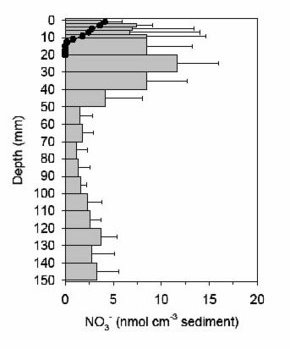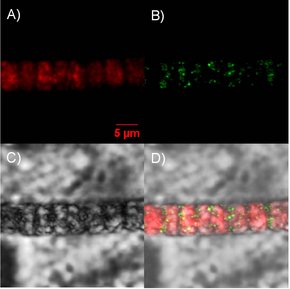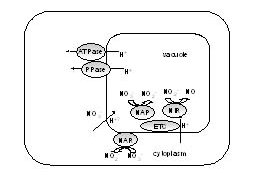Seitenpfad:
- Abteilungen
- Forschungsgruppe Mikrosensoren
- Leere Seite
Leere Seite
Die Inhalte dieser Seite sind leider nicht auf Deutsch verfügbar.
S-and N-cycling in cold seeps, animal associated microbes, diatoms and in marine sediments
Lichtschlag, de Beer, Heisterkamp, Stief, Schreiber, Kuipers, Schwermer, Weber, Abed, Allers, Wang, Kamp, Behrend
Anna Lichtschlag investigated biological and chemical pathways of sulfide oxidation in cold seeps. She found that in the Haakon Mosby Mud Volcano sulfide oxidation is entirely biological, as the sulfide flux is proportional to the nitrate uptake by Beggiatoa, and thus leads to primary production in this indeed rich and diverse habitat. Remarkbly, in a seep in the anaerobic zone of the Black Sea she found sulfide oxidation to sulfur, driven by extruded oxidised iron. In the mud volcano high CH4 levels have been mixed for millenia with oxidised Fe(III). This means that microbial CH4 oxidation by Fe(III) is probably impossible. Only after reduction of the CH4 by sulfate Fe(III) can be reduced.
Anna Lichtschlag investigated biological and chemical pathways of sulfide oxidation in cold seeps. She found that in the Haakon Mosby Mud Volcano sulfide oxidation is entirely biological, as the sulfide flux is proportional to the nitrate uptake by Beggiatoa, and thus leads to primary production in this indeed rich and diverse habitat. Remarkbly, in a seep in the anaerobic zone of the Black Sea she found sulfide oxidation to sulfur, driven by extruded oxidised iron. In the mud volcano high CH4 levels have been mixed for millenia with oxidised Fe(III). This means that microbial CH4 oxidation by Fe(III) is probably impossible. Only after reduction of the CH4 by sulfate Fe(III) can be reduced.

Anna Behrend aims to elucidate what controls whether DNRA or denitrification to N2 dominates. She started long- and short-term incubation experiments with sulfide and manganese additions, and will analyse the microbial processes and community shifts.
Anja Kamp (with Lavik & Kuypers) tested the hypothesis that diatoms store nitrate and can use it to respire in deep sediments. She has several lines of evidence that this indeed happens. This would explain the observation that nitrate can be found decimeters deep in coastal sediments.
Left: Distribution of nitrate from microsensor data (•) and total extraction (bars). The difference is intracellular in diatoms.
Anja Kamp (with Lavik & Kuypers) tested the hypothesis that diatoms store nitrate and can use it to respire in deep sediments. She has several lines of evidence that this indeed happens. This would explain the observation that nitrate can be found decimeters deep in coastal sediments.
Left: Distribution of nitrate from microsensor data (•) and total extraction (bars). The difference is intracellular in diatoms.
Calcification in marine sediments and freshwater stromatolites
Bissett, Schoon, Alexandra Rao, Polerecky, Martin Glas
It is well known that calcification is coupled to photosynthesis, and that benthic photosynthesis can lead to calcification. BioAcid is a large German collaborative research effort (Forschergruppe) funded by the BMBF, that aims to investigate the effects of ocean acidification on marine life. It was reported that calcification in corals and coccolithophores is reduced. We further investigate the hypothesis that benthic calcification, especially of phototrophs, is not very sensitive to acidification. The considerations are that the organisms create the site of calcification by metabolic processes, and that transport in sediments or the MBL is diffusionally restricted. Indeed microsensor measurements have shown that the surface pH of active sediments strongly deviates from the watercolumn. Alban Ramette from the Habitat group participates with a study on the effect of extreme acidification on microbial communities in seabeds near natural CO2 seeps. Also diversity of meio-, macro- and megafauna will be assessed to address thresholds of low pH on benthic ecosystems.
Extensive measurements in reef sediments (Schoon) during diel cycles showed that the pH value remained high during most of the night, and that calcification is not confined to the light period. A study on a hardwater creek, where calcification on tufas (sort of stromatolite) was thought to be driven by CO2 outgassing. However, in- and ex-situ microsensor measurements (Andrew Bissett) showed that calcification on the tufa is entirely controlled by photosynthesis. The outgassing does lead to calcium carbonate fall out, but this is washed away and does not reach the tufa. The effect of pH of the water column on benthic calcification was studied in the tufas and in reef sediments. In the pH range of 7.2-8.4 calcification was not influenced. It was concluded that the benthic microbial activity much more strongly determines the local pH than the pH of the seawater. This is highly valuable information in view of the ongoing acidification of the oceans, and the publication in AEM got an editorial comment.
Raphaela Schoon investigated whether calcification in silicate and carbonate sediments are equal, when seawater chemistry, amount of benthic phototrophs, photosynthesis rates and illumination are identical. Only in carbonate sediments calcification could be induced by illumination. This means that calcification needs calcite to proceed, probably as nucleus.
Alexandra Rao studies calfication and decalcification in permeable sediments. A very challenging task, but she is harvesting valuable data now, e.g. she measured the kinetics of calcification and calcium dissolution by rapid pH perturbations of the porewater. This is possible only in permeable sediments. Her second tool is modeling, in collaboration with Philip Meisman (NIOO, Nl).
It is well known that calcification is coupled to photosynthesis, and that benthic photosynthesis can lead to calcification. BioAcid is a large German collaborative research effort (Forschergruppe) funded by the BMBF, that aims to investigate the effects of ocean acidification on marine life. It was reported that calcification in corals and coccolithophores is reduced. We further investigate the hypothesis that benthic calcification, especially of phototrophs, is not very sensitive to acidification. The considerations are that the organisms create the site of calcification by metabolic processes, and that transport in sediments or the MBL is diffusionally restricted. Indeed microsensor measurements have shown that the surface pH of active sediments strongly deviates from the watercolumn. Alban Ramette from the Habitat group participates with a study on the effect of extreme acidification on microbial communities in seabeds near natural CO2 seeps. Also diversity of meio-, macro- and megafauna will be assessed to address thresholds of low pH on benthic ecosystems.
Extensive measurements in reef sediments (Schoon) during diel cycles showed that the pH value remained high during most of the night, and that calcification is not confined to the light period. A study on a hardwater creek, where calcification on tufas (sort of stromatolite) was thought to be driven by CO2 outgassing. However, in- and ex-situ microsensor measurements (Andrew Bissett) showed that calcification on the tufa is entirely controlled by photosynthesis. The outgassing does lead to calcium carbonate fall out, but this is washed away and does not reach the tufa. The effect of pH of the water column on benthic calcification was studied in the tufas and in reef sediments. In the pH range of 7.2-8.4 calcification was not influenced. It was concluded that the benthic microbial activity much more strongly determines the local pH than the pH of the seawater. This is highly valuable information in view of the ongoing acidification of the oceans, and the publication in AEM got an editorial comment.
Raphaela Schoon investigated whether calcification in silicate and carbonate sediments are equal, when seawater chemistry, amount of benthic phototrophs, photosynthesis rates and illumination are identical. Only in carbonate sediments calcification could be induced by illumination. This means that calcification needs calcite to proceed, probably as nucleus.
Alexandra Rao studies calfication and decalcification in permeable sediments. A very challenging task, but she is harvesting valuable data now, e.g. she measured the kinetics of calcification and calcium dissolution by rapid pH perturbations of the porewater. This is possible only in permeable sediments. Her second tool is modeling, in collaboration with Philip Meisman (NIOO, Nl).
Imaging of intracellular processes
Beutler, Hinck, de Beer
Martin Beutler and Jana Milucka (Microbiology) found that the vacuole in Beggiatoa is not a passive tank for nitrate, but generates energy for cellular use. Genomic information (Marc Mussmann, Molecolar Ecology Group) and a series of clever experiments revealed that the vacuole membrane has an electron transport chain, can reduce nitrate that generates a proton motive force (acidic and positive inside). A comparison with mitochondria is misplaced, the vacuole may have the same functions as the outer membrane, but is inverted as an invagination. Surprisingly, however, Cyt-c was only found in the vacuole. The vacuole is of course not a cell organelle, it can not replicate, DNA inside the vacuole was not found. It demonstrates how complex also prokaryotes can be structured.
Martin Beutler and Jana Milucka (Microbiology) found that the vacuole in Beggiatoa is not a passive tank for nitrate, but generates energy for cellular use. Genomic information (Marc Mussmann, Molecolar Ecology Group) and a series of clever experiments revealed that the vacuole membrane has an electron transport chain, can reduce nitrate that generates a proton motive force (acidic and positive inside). A comparison with mitochondria is misplaced, the vacuole may have the same functions as the outer membrane, but is inverted as an invagination. Surprisingly, however, Cyt-c was only found in the vacuole. The vacuole is of course not a cell organelle, it can not replicate, DNA inside the vacuole was not found. It demonstrates how complex also prokaryotes can be structured.


The vacuole as cellular powerplant. Nitrate reduction builds up a PMF (pH and potential difference), that is used to conserve energy in the form of poly-fosfate and ATP.
Immunostaining by antibodies showed that cytochrome c (thus a respiration chain) is present in Beggiatoa vacuoles. A) antibody Texas Red signal. B) reflection signal caused by sulfur globules. C) transmission image. D) overlay of A)-C).
Mass transfer and conversion in porous sediments
Wu, de Beer, Beck, Polerecky, Janssen, Sivelgen, Nemecki
In the ECODIS project we (Beck, Polerecky, Janssen) investigated the hypothesis that microbial processes can control trace metal exchange between sediment and water column. By a combination of laboratory experiments and field studies we could correlate diel fluctuations in a stream with benthic photosynthesis. The different behavior of Pb, Cu, Ni and Cd was explained by different responses to pH. The work resulted in a publication that was in unusually strong terms praised by the chief editor Jacques Buffle.
The study on mass transfer phenomena in the intertidal flats reaches its final stage. Christy Wu investigates the deeper areas under the flats to locate the source of the methane that seeps from the flats at low tide. She studied the biogeochemistry of two deep cores of 20 m length, including sulfate reduction and AOM rates. 14C dating of the C-org suggests exchange of organics and sulfate down to 20 m depth. She also measured porewater chemistry in transects from low water line to 200 m inwards. Instead of a local methane plume, she found a methane – sulfate transition zone ca 2 m below the surface everywhere. She will further search for the source of reducing power.
Lubos found new phenomena associated with bioirrigation activities of the lugworm Arenicola.
It was generally assumed that carbonate sediments are more microbially active than comparable silicate sands. This was investigated in detail by 2 MSc students on Elba, where the two habitats are closely together. Rates of respiration, photosynthesis and sulfate reduction were similar. No miracle with carbonate sands.
In the ECODIS project we (Beck, Polerecky, Janssen) investigated the hypothesis that microbial processes can control trace metal exchange between sediment and water column. By a combination of laboratory experiments and field studies we could correlate diel fluctuations in a stream with benthic photosynthesis. The different behavior of Pb, Cu, Ni and Cd was explained by different responses to pH. The work resulted in a publication that was in unusually strong terms praised by the chief editor Jacques Buffle.
The study on mass transfer phenomena in the intertidal flats reaches its final stage. Christy Wu investigates the deeper areas under the flats to locate the source of the methane that seeps from the flats at low tide. She studied the biogeochemistry of two deep cores of 20 m length, including sulfate reduction and AOM rates. 14C dating of the C-org suggests exchange of organics and sulfate down to 20 m depth. She also measured porewater chemistry in transects from low water line to 200 m inwards. Instead of a local methane plume, she found a methane – sulfate transition zone ca 2 m below the surface everywhere. She will further search for the source of reducing power.
Lubos found new phenomena associated with bioirrigation activities of the lugworm Arenicola.
It was generally assumed that carbonate sediments are more microbially active than comparable silicate sands. This was investigated in detail by 2 MSc students on Elba, where the two habitats are closely together. Rates of respiration, photosynthesis and sulfate reduction were similar. No miracle with carbonate sands.
Lophelia (Abed, Allers): CORAMM was a Statoil-funded project aimed to asses reported damage by oil exploration activities. We investigated the hypothesis that damage was caused by local anoxia and anaerobic microbial processes. However, we found that Lophelia quickly removes high loads of of sediment or drill cuttings. Complete burial is survived for 24 hours. Various other lines of evidence lead to the conclusion that Lophelia is far too robust to suffer from off shore activities, unless they are smashed by anchors or trawls. Community compositions from drill cuttings (essentially deep biosphere) and from seafloor sediments did not converge when exposed to the same condition. Ines Heisterkamp studies the N2O production by microbial communities associated with marine animals. She found that especially biofilm covered animals produce high amounts, although also gut communities can be very active. It is planned to expand the study to krill, DFG-funding for ship time is requested. Salinity dependence of denitrification in biofilms from desalination plants and hypersaline microbial is studied with Israeli partners. Communities appear to be adapted to precisely the ambient salinity. The biofilms are well structured laminated granules, with abundant methanogens. Denitratification stimulated methylamine formation, a substrate for methanogens. Calcification appeared to be driven by nitrite only, nitrate reduction to nitrite may occur only at the outer shell, or in the waterphase.
In a side project it was found that also humans produce high amounts of N2O, mostly from dental plaque. Nitrate is formed in the body by NO (neurotransmitter) oxidation and is concentrated in the saliva (ca 1 mM). Nitrate is reduced in the mouth to nitrite, and due to the acidity in the plaque (pH<6) and stomach, chemically to NO, and N2O. NO is thought to be essential in the sterilization of food in the stomach, and be important in fighting gum infections. Thus in humans, and likely in other animals, an unusual nitrogen cycle releases the greenhouse gas N2O.
In a side project it was found that also humans produce high amounts of N2O, mostly from dental plaque. Nitrate is formed in the body by NO (neurotransmitter) oxidation and is concentrated in the saliva (ca 1 mM). Nitrate is reduced in the mouth to nitrite, and due to the acidity in the plaque (pH<6) and stomach, chemically to NO, and N2O. NO is thought to be essential in the sterilization of food in the stomach, and be important in fighting gum infections. Thus in humans, and likely in other animals, an unusual nitrogen cycle releases the greenhouse gas N2O.
Microbial mats
Kohls, Abed, Polerecky, Al-Najjar, Hausler, Klatt, Chennu
Hyper Spectral imaging is now being developed for underwater use, in the EU network SenseNet. Chennu/Polereecky will measure community dynamics in phototrophic mats and on photic sediments, and improve video mosaicing of the deep-seafloor. A portable lab-system is currently used in various projects. In a sulfidic stream Polerecky, Klatt, Hausler study sulfide oxidation by anoxygenic- and oxygenic photosynthesis, aerobic and anaerobic oxidation by filamentous bacteria. The efficiency of light conversion to biological energy in 3 different ecosystems was studied by making balanced budgets: heat, reflection and photosynthesis. The quantum efficiency of mats from 5 different habitats was determined by PAM imaging, and compared with bacterial diversity measured by ARISA fingerprinting. Katharina Kohls found a novel type of migration in response to a salinity gradient. Raeid Abed has made a large library of fingerprints from source areas for dust (salt lakes in the Australian outback), he compared communities in dust and could locate the source area. He found that dust can contain strains found in Antarctica, Africa and Asia.
Hyper Spectral imaging is now being developed for underwater use, in the EU network SenseNet. Chennu/Polereecky will measure community dynamics in phototrophic mats and on photic sediments, and improve video mosaicing of the deep-seafloor. A portable lab-system is currently used in various projects. In a sulfidic stream Polerecky, Klatt, Hausler study sulfide oxidation by anoxygenic- and oxygenic photosynthesis, aerobic and anaerobic oxidation by filamentous bacteria. The efficiency of light conversion to biological energy in 3 different ecosystems was studied by making balanced budgets: heat, reflection and photosynthesis. The quantum efficiency of mats from 5 different habitats was determined by PAM imaging, and compared with bacterial diversity measured by ARISA fingerprinting. Katharina Kohls found a novel type of migration in response to a salinity gradient. Raeid Abed has made a large library of fingerprints from source areas for dust (salt lakes in the Australian outback), he compared communities in dust and could locate the source area. He found that dust can contain strains found in Antarctica, Africa and Asia.